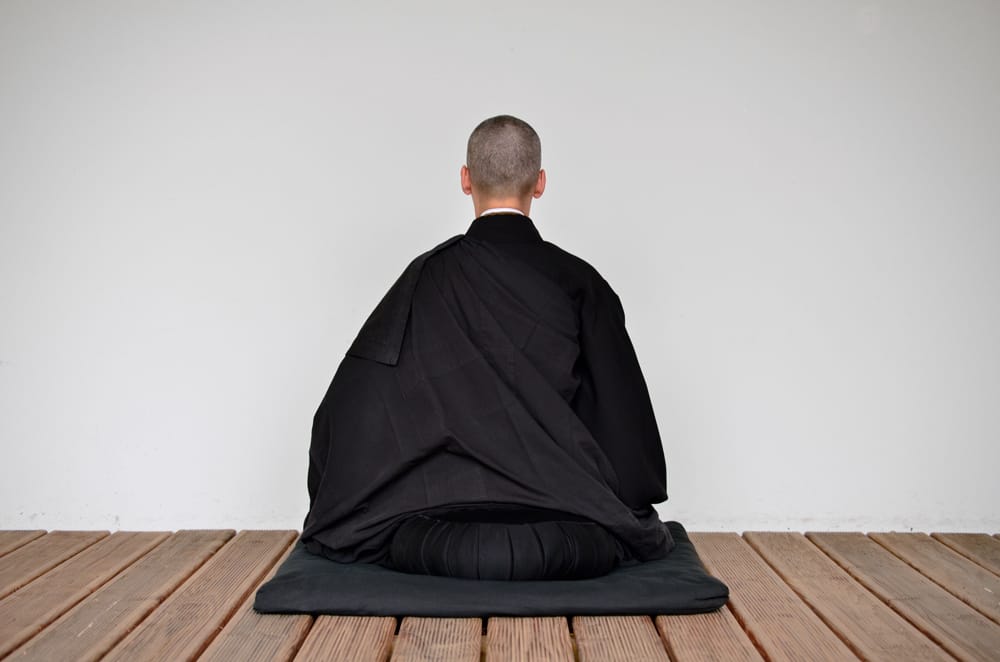The location of the gate — the forms of meditation — is fixed and known, but what will happen there can never be known ahead of time. Joan Sutherland on the place where form and formlessness meet.
As I think about the shapes and forms that meditative practices take, I keep returning to the afternoon before the fateful night in which a man named Siddhartha would sit under a tree, and at the rising of the morning star, become the Buddha. On that long afternoon, Siddhartha took a bowl, went down to the river, and made a vow: “If this bowl floats upstream, I’ll become enlightened before tomorrow dawns.” He threw the bowl into the river and bent all his intention to its journey against the current, against the unceasing tumble of being and doing and becoming, making and unmaking, birth and growth and decay and death—against the unrelenting torrent of stuff and matter, of thought and feeling and sensation, to the source of it all, in its stillness and eternity.
That is the same intention we set as we take up a meditative practice: we throw our bowls into the river, hoping to find its source. And yet we set this intention as embodied beings, in an embodied world of shapes, colors, sounds, tastes, and smells. We begin practice with bodily acts—breathing, postures, gestures, sounds, offerings, rituals. These are accompanied by acts at a subtler level of embodiment, acts of the heart–mind: the stilling of thoughts, mindfulness of sensation and emotion, the contemplation of a koan, visualization, prayer. We trust that the world’s radiant, eternal aspect is not outside our experience but an enlargement of it, and so it is with eyes and skin and hearts that we go out to meet it.
The bowl Siddhartha flung into the river did float upstream, but he chose to follow it by turning back toward the world. He bathed in the river, and then he went to sit under a tree. The world came to meet him, to offer its support: he encountered a grass-cutter, arms full of soft, fragrant green, who offered him some grass as a cushion.
On that first afternoon there was no formal Buddhist practice yet; there was only Siddhartha’s brilliant improvisation in a landscape of river and grass and tree. But over millennia we’ve added a gate to the landscape: We’ve created an edifice of meditation, made of an architecture of methods. Rather than examine its individual stones, let’s look at the gate in its original setting, there by the tree. Let’s look at what it’s like to sit in its shade, at the place where things come in and out, and meet each other.
There is the gate, always in the same place, enduring, unmoving, and yet with an opening that invites things to pass through it. There is the person who comes to sit at the gate, different every time, agreeing to stay put so that those things moving in and out of the gate can find her. The location of the gate—the forms of meditation—is fixed and known, but what will happen there can never be known ahead of time. The experience of sitting at the gate is made up, inseparably, of both what is repeated and what is spontaneous—what can only happen in this moment, in this place, amidst these circumstances with what we bring to the gate and what comes through it.
We sit down and gather ourselves. We are creatures of habit, using habit—a particular sitting posture, the smell of incense, the sound of a chant repeated many times—for our benefit, to bring body, heart, and mind together. In gathering ourselves we make ourselves available to be acted upon, to be marked by the worlds, visible and invisible, in which we sit. Available to what comes through the gate.
We’re making an offering of ourselves. We’re announcing our desire for the deepest meeting of all, the one between the vastness and the individual, between what is without form and what exists as form. We offer ourselves as the place where these two great realities might meet and mix and create something new.
Fortunately for us, people have been making this offering for thousands of years and have developed some good ways to do it. The constancy of forms and their repetition make a field that holds us until we can hold ourselves. At the very least, we can fall back on forms, just do them no matter how we’re feeling, in the same way we can fall back on courtesy when our natural instincts fail us. We can consent to a form and surrender for a while. The poet Adam Zagajewski writes about how the things of the world agree to every minute of the year, every change in season or the weather, so that they can go on living. In meditation each of us acknowledges that we too are things of the world.
Just as the postures of meditation are a way of holding the body still long enough for something to happen, our consent is a way of holding the heart–mind still, creating an opportunity for something to find us and strike up a conversation. For a while, at least, we are saying that we won’t turn anything away; we won’t jump to categorize or assign value to things. We’ll just listen. For this little while we agree not to know, and to follow where the form takes us.
Through the gate come our subjective experiences—our inner narratives, moods, and physical sensations. After awhile, meditation also shows us what it’s like before the shaping power of thoughts and feelings kick in. We consent to giving the usual cognitive and emotional filters a rest, so that meditative forms can influence us at deeper levels. Over time they change how we perceive and feel about things, how our intuition works, and even how we respond somatically, before cognition. We are allowing the long, slow waveforms of tradition and practice to act upon the spiky graph of our moment-by-moment experience.
This can be hard work, and it takes some trust, so it’s helpful that we discover pretty quickly how not alone we are. There’s the tradition and the ancestors; we’re sitting with everyone who has ever sat. The gate is an address the ancestors recognize, and through it they come, bearing their encouraging and their disorienting advice. Through the gate come intimations of the vastness and of the source of the river of being. The vastness doesn’t need an address to home in on since it’s already everywhere, but we need to be able to receive it. It’s one of the beautiful paradoxes of meditative practice that consenting to occupy a particular, small location in a very particular way—body arranged like this, heart–mind like that—actually opens us to the unbounded, immeasurable aspect of reality. What exists as form meets what is without form.
As these various aspects of the world begin to meet up in the field of our meditation, sometimes things flow together easily and the field effortlessly expands. We discover ways to harmonize with the rhythms of the Earth and eternity. We realize that we’re becoming the place where the teachings take on actual, embodied life. When we practice together, our individual, introverted practices connect us with others and we become part of an even larger field.
Sometimes there’s tension. Perhaps the most important aspect of our consent is the willingness to stay put, and even to be interested, when the things that come through the gate seem to jostle each other and argue with us, or provoke us to argue with them. Sometimes becoming intimate with the realm of thoughts and feelings is tremendously painful. Sometimes the ancestral voices seem not just inscrutable but crazy or wrong. Sometimes the vastness is overwhelming and frightening. The conversation at the gate becomes colored with complaint, mistrust, or fear.
That’s when it’s good to feel solid stone at your back, something you can lean against when the field starts to spin. To stay with a form when things get dicey is simply to choose the ground upon which to meet the disturbance. Since we focus so much on meditation’s stilling and expansive qualities, it might seem surprising that one of the intentions of meditation is to put us in a state of tension. The steadiness of meditative forms allows apparent dualities to emerge, and the invitation is not to smooth over their differences or choose between them. Doing either is settling prematurely; it’s settling before unsettling tension can become creative.
For example, meditation might go along quite deeply and peacefully for awhile, and then one day it’s filled with agitation and rumination. Has something gone wrong? Was there good meditation and now there’s bad? Here’s a tension. If we refuse to choose a label and widen the perspective a little, we might notice a couple of things. The external form remains the same; we’re sitting the way we always have. Is there something internally that also remains the same, something underneath states of either peace or agitation? Perhaps we discover that the field of meditation is constant, and it’s just a matter of different qualities and states arising in it. This is how a tension between apparent dualities becomes creative, pointing us to a third thing that includes both and is bigger than either. To the extent we can shift our allegiance from the transitory states to the constant field, we begin to create a new possibility, a new way of living.
If we stay put long enough, we’ll confront the largest tension of all: that we and everything else are formed and formless at the same time. As we learn to see the creative potential of the smaller-scale tensions in our meditation, we experience for ourselves how the apparent tension between form and formlessness resolves itself over and over again to produce the manifest world.
All helpful forms eventually have to blow themselves up. Everything has its shadow, and the danger in having a static relationship with meditative forms is when we focus primarily on getting them right. When we do this, correct form is no longer a beautiful means of discipline and surrender, but the goal itself. Instead of providing a liberating experience of the largeness of things at the intersection of form and emptiness, the forms of practice can become constricting and self-centered affectations. Eventually we have to break free of the idea that a particular state of heart–mind is dependent on a particular meditative form. What we experience by sitting at the gate has to roll out in a kind of slow-motion explosion to affect the rest of our lives. The original form doesn’t necessarily disappear; we might continue to practice it. But it becomes something less bounded and more fluid, present in more of our lives, taking the form of whatever we’re doing.
This is the final tension: that which is between formal discipline and the formless permeation of meditation throughout our lives. As we hold the tension, we might notice that a remarkable transformation is taking place. The gate has begun to impress itself on us, and we are taking it in. The gate made of stones is becoming flesh and blood, hands and eyes; it is becoming a part of us wherever we are. The decision to sit down at the stone gate in that ancient landscape is made by individuals, one by one, but there are no limitations on who and what can be affected by a gate made flesh, carried into the world.

